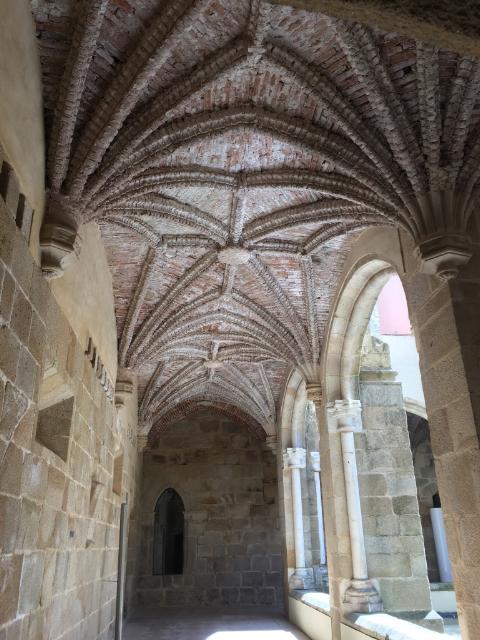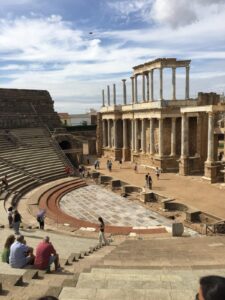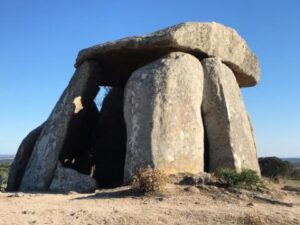
Back Roads Alentejo Tour (Spring 2024)
May 23 - June 2, 2024
The Back Roads Alentejo tour takes you through agricultural Central Portugal, with wide expanses of olive trees, vineyards, citrus groves, and cork oak plantations. We will travel to medieval towns with their defensive architecture of castles, churches, and plazas. Many are UNESCO-designated World Heritage Sites. After we greet you at the Lisbon airport, we begin our journey to historic Palmela, then midway in our travels, climb up to the Eagle’s Nest that is Marvão, and finally we will arrive again in historic Lisbon. Towns we will experience along the way include Évora, Estremoz, Elvas, and Mérida, Spain, largely on peaceful back roads. This is a region with its own pace and time, with echoes of past battles beyond the walled cities created by the tenacity of the people, where culture and spirituality take on a unique character.
Check out the full description below!
- Overview
- Description
- Itinerary
Tour Info
RATING SYSTEM: Level 2 (rating system info)
DURATION: 11 DAYS / 10 NIGHTS
REGION: Alentejo
ACCOMMODATION: 3-4 star hotels (or similar); historic and country inn properties
PRICE: $3950 (sharing double room)
SINGLE SUPPLEMENT: May apply.
DISCOUNTS: May be available for client recruitments. Bespoke tours for those with special needs and families may be available. Inquire through comments.
GROUP: Minimum 2-4 Travelers, Maximum 8 Travelers
AGE REQUIREMENT: 18+ years old
We will be following all Portuguese health regulations and staying in accommodations certified “Clean and Safe” (issued by the Portuguese National Tourism Authority).

Included
- 11 days
- 10 nights at 3-4 star accommodations (or similar)
- 10 breakfasts at the hotel
- 2 lunches and 4 dinners, including Welcome Lunch at Seaside Restaurant in Serra da Arrábida Natural Park and Farewell Dinner at Fado Restaurant in Lisbon
- Alcoholic beverages not included with any tour meals, unless otherwise specified
- Standard group arrival/departure transfers: from Lisbon Airport to Hotel in Palmela on Day 01 and to Lisbon Airport from Hotel in Lisbon on Day 11
- Transfers from and to the hotel by vans, mini-bus or cars
- Luggage transfers (one piece of luggage per person)
- English-speaking guides
- Tile-painting workshop and factory tour near Palmela
- Tour of 16th-century palace and wine-tasting near Palmela
- Visit to Traditional Bonecos Workshop near Évora
- Guided Wine-Tasting near Palmela, Évora and in Estremoz
- 3 Guided Historic Walking Tours and 2 hikes
- Visit Olive Oil Museum
- Visit to 4 UNESCO sites and 2 demonstrations of UNESCO Intangible Cultural Heritage of Humanity art/craft/song
Excluded
- Airfare, train and bus tickets, museum fees, and other costs not specified are excluded from the tour price.
Description
The Back Roads Alentejo tour takes you through agricultural Central Portugal, with wide expanses of olive trees, vineyards, citrus groves, and cork oak plantations. In addition, we will travel to medieval towns with their defensive architecture of castles, churches, and plazas; many are UNESCO-designated World Heritage Sites. After we greet you at the Lisbon airport, we begin our journey to historic Palmela, then midway in our travels, climb up to the Eagle’s Nest that is Marvão, and finally we will arrive again in historic Lisbon. Towns we will experience along the way include Évora, Estremoz, Elvas, Mérida, Spain, Marvão and Lisbon by largely peaceful, scenic back roads. This is a region with its own pace and time, with echoes of past battles beyond the walled cities created by the tenacity of the people, where culture and spirituality take on a unique character.
We will begin our travels near the Atlantic Coast and the Serra da Arrábida Natural Park with a visit to historic Palmela. We will stay within the castle walls at the modernized monk’s refectory to gain a more intimate flavor of that time. The site still retains its historic qualities and we will spend time there, roaming the ramparts and tiled church.
Heading inland from the coast, briefly we will visit historic Évora, designated a UNESCO site in 1986. The remains of its Roman temple and Évora’s Cathedral draw you into its historic center. We will also visit a small local studio that produces extraordinary clay figures called the Bonecos of Estremoz, whose designs and production date back to the 17th century. This art form was recognized in 2017 as a UNESCO Intangible Cultural Heritage of Humanity. From Évora, we journey to Estremoz, a UNESCO city, where we will visit a tile museum and sample some local wines.
Moving closer to Spain, we visit Elvas, another UNESCO city that is the home to some of the most impressive fortifications in Europe. Traveling across the border briefly into Spain, we will visit the Roman structures at Mérida, another UNESCO site! These magnificent ruins demonstrate a way of life around 1 BC that consisted of the Temples of Diana, massive Roman amphitheater that held up to15,000 spectators who witnessed fights between gladiators and wild beasts and the Roman theater. Mérida was one of the largest capitals of the Romans and was established in 25 BC.
Back in Alentejo, we will find concentrations of megalithic stones, like dolmen that mark places that were funerary in nature and some others of unknown meaning. These fascinating structures signify that pre-historic habitation occurred here as well. We will visit a few of these.
For most of our journey, we will travel through this region of world-class wines where five of Alentejo’s eight demarcated wine regions are located. Of course we will be sampling delicious wines from the region along our route.
Heading north from Elvas, we cross sections of the Serra de Mamede, a remote mountain range with diverse geology and an historic line of impressive defensive settlements, erected to protect the border from hostilities. The walled town of Marvão or the many ancient dolmens will recall the magic of this region. Around the hills, white-washed houses stand on hills, castles evoke past battles and the gardens we will pass bear witness to the Moorish influences that shaped both people and Nature. Here, we will also discover lilac fields, watch unique birds and find unforgettable landscapes in the mountain, in the cork oak forests, or on the plains in the olive groves. The freedom and relaxation we will discover passing along these lightly-traveled country roads will evoke a feeling that will stay with you long after our tour is over.
Come join us on this exciting cultural and natural adventure for a unique look into the past and the present of a region that has maintained its authenticity for centuries!




Itinerary
DAY ONE: GETTING STARTED
Thursday, May 23, 2024
Transfer from Lisbon Airport to Marvão
Transfer from Lisbon Airport to Palmela
Overnight in Palmela
Meals: Lunch or Dinner on your own
After we gather everyone at the Lisbon Airport Meeting Point, we will hit the road and head toward the coast. An hour or so later, we arrive in Palmela, a scenic hill town that became the seat of the Order of St. James in 1423. Here King Sancho I gave the castle at Palmela to the Order of St. James, after they conquered the castle from the Moors. Its highly strategic promontory, overlooking the wooded natural park and the city of Setúbal, provides wonderful high views of the surrounding area. We will rest within the castle walls, allowing time for you to wander the Castle and the Church and Monastery of St. James, appreciate the scenic views or have a drink in the monastery’s courtyard.
DAY TWO: ENJOYING THE BLUE COAST
Friday, May 24, 2024
Morning Transfer to Olive Oil Museum and Return to hotel in Marvão
Overnight in Palmela
Meals: Breakfast and Lunch included, Dinner on your own
Traditional Tile Painting Workshop and Factory Tour
Welcome Seaside Lunch
After a sumptuous breakfast, we will head out to a local tile shop where we will be taught to paint traditional and modern designs on tiles. Tomorrow we will retrieve our tiles to take with us. After the workshop, we will be given a walking tour of the tile production area. The Serra da Arrábida Natural Park awaits us as we make our way down some winding roads to the waterfront. There we will have a feast of fresh fish or other selectionS, overlooking the water. There is no rush to hurry through lunch and we will enjoy the peaceful, friendly atmosphere and the delicious food; if you select the grilled seafood (we selected the sea bass), it most likely was caught just that morning in the waters before you. After lunch, we head back up the hill through the Natural Park to once again enjoy our Castle retreat for the evening.
DAY THREE: ALENTEJO WINE COUNTRY
Saturday, May 25, 2024
Overnight in Arraiolos
Meals: Breakfast and Dinner included, lunch on your own
Palace Tour and Wine-tasting
Traditional Portuguese Dinner
After breakfast, we check out of our Palmela lodgings and we return to Azeitão to pick up our tiles and to tour a 14th century Palace and Quinta (farm). The architecture id reminiscent of the Palace that displays 15th and 16th century tiles, evoking Moorish designs and houses furnitishings and decor that reflect the influences of the Portuguese Discoveries, former owner’s travels to the rest of Europe, the coast of Africa and the East. The private, manicured gardens are surrounded by vineyards as well and the setting of this singular gem provides a relaxing respite from the busy streets beyond. We return to the winery to try some local wines, including the regional moscatel.
After this activity, we continue our journey into Alentejo. Alentejo is famous for its vast plains, numerous cork trees and olive groves and vineyards that stretch across the horizon, almost for ever. This is one of Portugal’s most important wine-producing regions, whose wine production dates back 4,000 years. The occupying Romans (from the 3rd BC to the 4th century ACE) introduced fermentation through the use of amphora clay vessels. The Moors suppressed wine culture here until they were driven out in 1093. Wine production was resurrected for real after the Carnation Revolution overturned the Salazar Dictatorship (1937-1974) in 1974. Today, there are 14 designated wine regions in Portugal and the Azores and Madeira Islands; Alentejo was made a demarcated wine region in 1988. Today, we travel to Arraiolos, a short distance outside of Êvora, a village that specilaizes in traditional woven rugs. After we check in and have a chance to relax, we will walk together into the village to enjoy a traditional Portuguese meal.
DAY FOUR: COUNTRY OF STANDING STONES
Sunday, May 26, 2024
Overnight in Bencatel
Meals: Breakfast and Lunch included, Dinner on your own (Redondo)
Visit to the Standing Stones: Almendres Cromlech (Cromeleque dos Almendres) and Interpretive Center
Brief Visit to Évora
Picnic Lunch and Visit to Bonecos de Estremoz (traditional clay figurines): Demonstration and Studio Tour
Wine-tasting at Local Winery
A visit to the cromlech is a surprising experience. It is a megalithic complex and is the largest existing group of structured menirs (standing stones) in the Iberian Peninsula (and one of the largest in Europe). The construction of these structures dates back to 6000 BC but were only discovered officially in 1966 by a Portuguese geologist. It is unknown what the exact intent of the stone’s grouping is; however, research suggests that the space may have had a religous or ceremonial purpose or may have functioned as a primitive astrological observatory. We will never know for sure but the experience of walking through these megaliths is unforgettable.
By now, you will have noticed that this part of Portugal is dotted with thousands of evergreen cork oaks (Quercus suber). Alentejo, Portugal is the world’s top producer of cork wine stoppers; cork grown from the evergreen cork oak (sobreiro) has been sustainably harvested since the 1700s. With 2700 square miles under cultivation, groves throughout Alentejo produce 30 million corks per day. Cork bark is a versatile material and also is used for insulation, flooring, traditional crafts, such as cork bowls, handbags, furniture, jewelry, and decorated boxes. We will probably see piles of harvested cork bark and organized in towering piles as we pass through some villages.
Today, we briefly explore the historic center of Évora, designated a UNESCO site in 1986. The Roman Temple ruins from the 2nd or 3rd century still stand adjacent to the 12th century Cathedral and the Museum of Évora, once a Palace of the Governors in the 16th century. The now highly fragmented Roman inner walls around the medieval city, date to 1st century, while additional walls date from Moorish and Medieval times.
Before we arrive for our afternoon wine-tasting, we will take a break near São Miguel de Machede to have a picnic and to visit a small studio that produces the Bonecos of Estremoz. We will be able to observe the complicated process required to produce these figurines and the significance of the over 100 traditional designs captured in clay. This home studio is reminiscent of the studios that began producing these figures in the 1700s.
We will pass through Redondo and its surrounding quaint countryside of farmland and rolling hills, where we will have dinner at a local restaurant (on your own). Vineyards surround the town and it is the heart of one of the region’s demarcated wine sub-regions. We will overnight at a country inn closeby where you will probably hear the neighboring sheep bells the next morning. We will be housed in small, modern bungalows that still retain the flavor of the Portuguese countryside.
DAY FIVE: ENJOYING THE COUNTRYSIDE AND A UNESCO TOWN
Monday, May 27, 2024
Overnight in Bencatel
Meals: Breakfast and Dinner included, Lunch on your own
Visit to Estrmoz Castle, briefly – UNESCO site
Visit to Tile Museum, including a Wine Tasting
BBQ Dinner at the Country Inn
After breakfast at our inn, we will venture to Estremoz via the backroads today, leading us past the Serra D’Ossa Mountain Range. These low traffic roads will allow us to soak up the landscape before we enter another medieval, UNESCO-designated town. Yesterday, we visited a small studio that produces bonecos and today we will visit the place where this craft began. Since the 16th century, the town has been known as a pottery center, including hand-painted terracotta pottery and typical designs from royal times. The local traditional craftsmanship of historical Estremoz clay figurines, known as bonecos (painted clay dolls of saints and peasants depicted in daily tasks, such as selling eggs, roasting chestnuts or other typical activities) was recognized in 2017 as a UNESCO Intangible Cultural Heritage of Humanity.
Estremoz, still dominated by its medieval castle, is another hill town and celebrates an annual Baroque Festival that brings its history to life! We will briefly explore the castle but we will spend more time at a local tile museum that houses Portuguese and Spanish tiles that date back 800 years to the 20th century. The congenial atmosphere of the museum and courtyard is only augmented when we realize that the price of admission also includes a wine tasting!
After we have decided what wines we are having for dinner, we will return to our country inn for an outside BBQ.
DAY SIX: WALKING THROUGH HISTORY: ENCOUNTERING THE ROMAN EMPIRE IN SPAIN
Tuesday, May 28, 2024
Overnight in Elvas, Portugal
Meals: Breakfast included, Lunch and Dinner on your own
Visit Mérida, Spain – UNESCO site
The Roman Empire expanded its settlements throughout Portugal and Spain during the 3rd to 4th centuries BC. The Romans invaded and conqueored Spain in 218 BC and Portugal in 210 BC. Mérida was a large Roman city, founded in 25 BC, under the name of Emerita Augusta after the Roman Emperor Augustus to serve as a retreat for legions of Roman war veterans (hence, emeritus). It served as the Roman capital of Lusitania (Portugal) and then as the capital for all Hispania (including Spain) during the 4th century. The structures we can presently witness in Mérida include the remains of a Roman theater and amphitheater (built around 105 AD for entertainment and other purposes), a Roman amphitheater house (mansion, really, with numerous mosaic floors built at the end of the 1st century AD), the circus (built at the end of the 1st century AD for entertainment purposes), the Temple of Diana (built and others (that we won’t be visiting). The Roman Empire retreated from this part of the world after other invading parties forced them out and eventually was under Muslim rule in 713 AD until approximately 1230 AD. The rest of the Roman city is still buried under the present day one. There area myriad of outdoor cafes around the theater for lunch on your own.
After a full day of sightseeing in Mérida, we head back to Portugal to our hotel in Elvas.
DAY SEVEN: WALKING THROUGH HISTORY: PORTUGUESE GARRISON BORDER TOWN AND FORTIFICATIONS
Wednesday, May 29, 2024
Overnight in Crato
Meals: Breakfast included, Lunch and Dinner on your own
Visits to two UNESCO Fortifications and Walking Tour
Elvas sits on the Spanish border, an historically strategic location where defending the Portuguese border from the Spanish became a constant reality during the Wars of Reconstruction during the 17th century. It is protected by two magnificent star forts constructed and enhanced during the 18th century. We will visit both forts. The fortresses construction was from 1763 to 1792. Surrounded by medieval walls, these forts are considered to be two of the world’s most powerful bulwark fortresses. Elvas was designated a UNESCO site in 2012 as “Garrison Border Town of Elvas and its Fortifications” and represents the largest bulwarked dry ditch system in the world. We will walk from one fort to the other to experience the flavor of the area and continue our journery towards the mountains after our walk and lunch.
Leaving Elvas, we continue through this rural area, rich in olive groves and cork oak trees, toward the town of Crato. Much of Crato was sacked and burned by the Spanish in 1662 but a few buildings remain rebuilt, such as the Mother Church (Igreja Matriz), found at the end of a road lined with orange trees, and inside decorated with 18th century tiles (azulejos) depicting fishing, hunting and traveling scenes. Crato remains a peaceful village at the foothills of the Serra de São Mamede (in 1989, 120 square miles of the Serra de São Mamede was designated a Nature Park by the EUROPARC Federation). From Crato, we pass through Flôr da Rosa to reach our hotel, a town known as a pottery manufacturing center that produces a round cooking bowl called the caçoila. We will be staying at the Flor da Rosa Monastery, the 1356 monastery-fortress of the Order of the Knights of Malta near Crato. Within the monastery, you will find two small museums that tell the story of the monastery and surrounding area that you can peruse on your own.
The Portuguese Office of Tourism is located also within the monastery and just ask one of the employees to show you the historic church that resides within those walls. The tour will be worth your time and will open your eyes. Otherwise, relax by the pool with wonderful views of the castle and have a snack in the bar.
DAY EIGHT: ASCENDING INTO THE SERRA (MOUNTAINS)
Thursday, May 30, 2024
Overnight in Marvão
Meals: Breakfast and Dinner included, Lunch on your own
Visit to the Jewish Quarter (Judaría) in Castelo de Vide
After beakfast, we will be stop in the city of Castelo de Vide for a visit before we head up the mountain to Marvão. Castelo de Vide, a spa town since Roman times, is sited on the green slopes of the Serra de São Mamede. One of the sources of the curative waters is the Renaissance era Village Fountain (Fonte da Vila), located below the Castle and the maze-like Jewish Quarter (Judaría), which dates to the 13th century. A small synagogue, now a Tourism Office and museum, lies behind fine Gothic doors in a narrow, steep cobble-stoned alleyway. We will begin our guided tour at the bridge that was the entry into Portugal for Sephardic Jews escaping the Spanish Inquisition in the 16th century.
We leave Castelo de Vide and climb 2800 feet to the medieval mountaintop village of Marvão. It is one of Portugal’s most spectacular fortified towns. It is perched on the top of a wall of granite like an eagle’s nest and built into the granite itself. It is the only Portuguese fort to have never been overcome by invading armies. Once there, you will understand why. Marvão still maintains its fortress-like character; one enters the village through gigantic double doors flanked by watchtowers, curtain walls and battlements. The castle that overlooks the town, dates to the late 13th century and the buttresses were remodeled in the 17th century. The views from the Castle show a vast panorama of the rugged Spanish mountains to the east, the Castelo Branco region and Serra da Estrela mountains to the north and the Serra de São Mamede in the south. Within minutes, we are instantly transported back to a different time and place. The 13th century Church of St. Mary (Igreja de Santa Maria), now houses the Tourism Office and the Municipal Museum where you will find megaliths, copies of old maps of Marvão and Roman stelae or stone monuments to the Dead. Other churches date to the Renaissance.
The greatest attraction in Marvão is the unspoiled medieval atmosphere of the immaculately white-washed houses and its steep and narrow lanes (some carved out of stone itself) that lead to the magnificent 13th century castle that seems to spring from the rocks. What a place with its manicured castle garden and 360 degree views! Most rewarding and exciting of all is climbing up on the walls, battlements and towers for the impressive views of the Alentejo plains and border of Spain. Stay for the stunning sunset and evening peace of the village.
Feel to roam Marvão until we reconvene for dinner together at our hotel.
DAY NINE: RETURNING TO LISBON
Friday, May 31, 2024
Overnight in Lisbon
Meals: Breakfast included, Lunch and Dinner on your own
Visit to and Lunch at Olive Oil Museum
After our breakfast in the hotel, we will venture back to Lisbon but before we leave this scenic region, we will stop a heritage museum that tells the story of olive oil production and the importance of the olive oil trade in Portugal. We meet at the museum for a Guided Tour of the museum dedicated to olive oil production, which is followed by lunch with an olive oil tasting.
Once back on the road, we will arrive at our hotel in the hilly Alfama section of Lisbon and you will have the rest of your afternoon to explore this pleasant and historic area.
DAY TEN: EXCITING LISBON
Saturday, June 1, 2024
Overnight in Lisbon
Meals: Breakfast and Dinner included, Lunch on your own Farewell Dinner at Local Fado Club (Beverages included)
After a leisurely breakfast, you will have the day to wander to your heart’s delight in Lisbon. Lisbon is a wonderful city. Nestled amongst seven hills, it offers a myriad of opportunities to experience its colorful maritime history, wander through magnificent religious architecture, such as the Geronimos Monastery or sit in a bustling sidewalk cafe drinking coffee (or something a little bit stronger). Enjoy your day! We will reconvene in the evening to celebrate our tour together with a hearty traditional Portuguese meal that combines with a Fado show of singing and fun in between four courses of authentic dinnerfare. Fado (portuguese for destiny or fate) is a kind of lamenting Portuguese “Blues” and was born in the 1820s in the bohemian sections of Lisbon, specifically in the Alfama where we’re staying. Times were hard and song was a refuge from the pain of poor and heart-breaking daily life. Amália Rodrigues or simply known as “Amália”, popularized Fado in Portugal in the 1940s, making Fado a global sensation. In modern times, Fado has evolved but still retains a sense of meloncholy and resignation. Fado is designated a UNESCO Intangible Cultural Heritage.
We will walk back together to the hotel for a restful night’s sleep.
DAY ELEVEN: GOING HOME
Sunday, June 2, 2024
Meal: Breakfast included
Morning Transfer to Lisbon Airport
At the designated time, we’ll take you to the Lisbon Airport by private car/van.